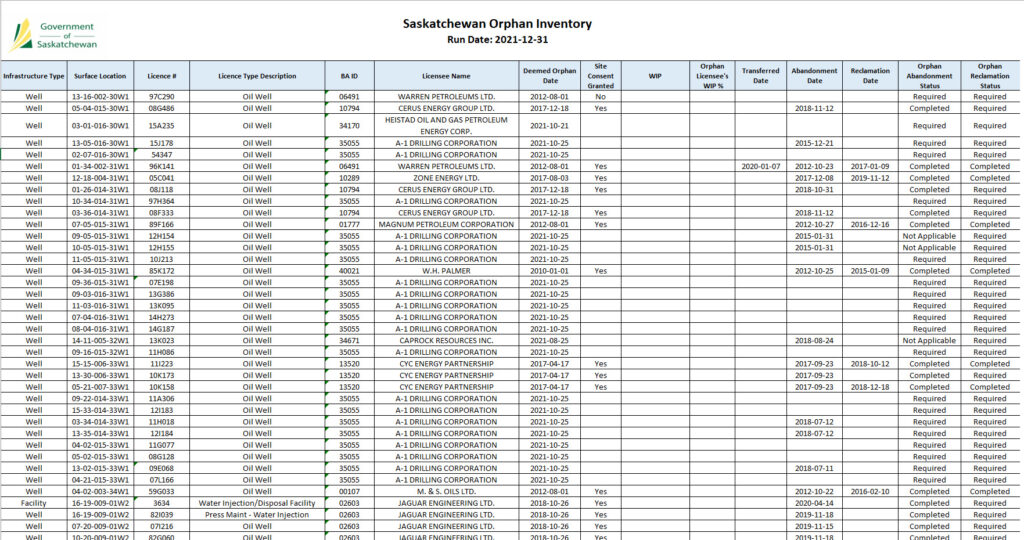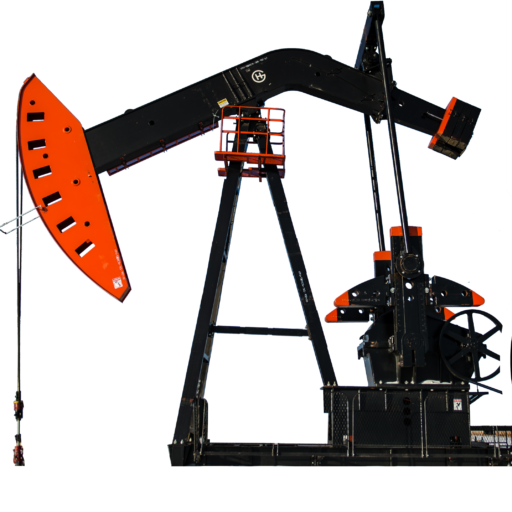The parliamentary budget officer has found the cost of cleaning up orphaned oil and gas wells in Alberta and Saskatchewan already dwarfs the money collected from industry to pay for it.
But critics immediately called Yves Giroux’s estimated $1 billion by 2025 price tag a massive underestimate.
“It’s a great disappointment,” said Regan Boychuk of the Alberta Liabilities Disclosure Project, a group whose research was cited in Giroux’s report.
“They left out the most expensive part.”

According to the Saskatchewan Ministry of Energy and Resources, there are, or were, 1,627 wells and facilities listed as orphaned as of Dec. 31, 2021. Of those, the orphan abandonment status was “completed” for 748, “no longer required” for 147, “not applicable” for 234, leaving 496 still on the list. The whole list can be found here. https://www.saskatchewan.ca/business/agriculture-natural-resources-and-industry/oil-and-gas/liability-management/orphan-fund-procurement-program/orphan-inventory.
The report considers about 10,000 wells in Alberta and Saskatchewan that are considered orphans — those with no viable operator capable of addressing their environmental liabilities. It says the cost of cleaning up those wells is currently $361 million and will rise to $1.1 billion by 2025 as the number of orphan wells grows 35 per cent a year.
Industry has paid only about $237 million in security deposits, the report says.
It adds the federal government has already devoted $1.7 billion to well cleanup and say about half of that has already been given to 10 viable energy companies, including giants such as Canadian Natural Resources Ltd and Imperial Oil.
But the report is careful to mention what it doesn’t include.
The cost doesn’t include cleanup of pipelines or other energy infrastructure on the land. It doesn’t include oilsands.
It does not include 7,400 wells that are considered abandoned but not yet orphaned. If those wells were included, the report says current liability would more than double to $801 million.
It doesn’t include liability from the 225,000 wells in Alberta and Saskatchewan that are considered inactive or plugged. Nearly two-thirds of all wells in those provinces no longer pump, the highest percentage ever, and most wells declared inactive never start again.
Nor does it include the full cost of cleanup.
The report only considers the cost of tidying up the land surface and removing equipment. It doesn’t consider the costs of remediating ongoing contamination from underground chemicals or leakage.
“The exclusion of remediation will understate the total cost of well cleanup,” the report says.
There isn’t enough data on the highly variable costs of such cleanups to make a meaningful estimate, said Giroux.
“The data is very limited on this. The reclamation costs can vary greatly from one well to another.”
The report estimates the cost of plugging and reclaiming a well to be about $78,000. That’s less than half the estimate from the Alberta Liabilities Disclosure Project.
Boychuk said the report’s focus on orphan wells is misleading. Legislation already exists to force industry to fund cleanup of those wells, he said, and it’s all the other wells and infrastructure on the land not yet classified as orphaned that are the threat.
“It’s not about orphans,” he said.
He criticized the report for only looking at publicly traded companies and for using the same methods used by the Alberta Energy Regulator to determine a company’s financial health and to define an orphan well.
He said there are 8,000 wells belonging to hundreds of companies bankrupt in all but name that aren’t included in the report’s calculations.
“There is no number in that report that is reliable and credible and defensible.”
The report points out there are environmental costs to unreclaimed wells on the landscape.
Those wells are estimated to release the equivalent of 545,000 tonnes of carbon dioxide every year. As well, Alberta’s energy regulator says about 10 per cent of inactive wells and seven per cent of abandoned wells leak. Farmers and ranchers complain about poor weed control contaminating their crops and pastures.
Spokespeople from the Alberta government and the Canadian Association of Petroleum Producers were not immediately available to comment on the report’s findings.
This report by The Canadian Press was first published Jan. 25, 2022.
— Follow Bob Weber on Twitter at @row1960
Bob Weber, The Canadian Press
- 0098 SASPO-2874_Self Serve Campaign_New Connects_Youtube_v30098 SASPO-2874_Self Serve Campaign_New Connects_Youtube_v3
- 0100 Turnbull Project Manager0100 Turnbull Project Manager
- 0099 Mryglod Steel 1080p0099 Mryglod Steel 1080p
- 0097 Eagle Sky Ventures LTD0097 Eagle Sky Ventures LTD
- 0095 Fast Trucking nearly 70 years good at it0095 Fast Trucking nearly 70 years good at it
- 0053 Kingston Midstream Westspur Alameda Click Before You Dig0053 Kingston Midstream Westspur Alameda Click Before You Dig
- 0092 Turnbull projects big and small0092 Turnbull projects big and small
- 0046 City of Estevan This is Estevan Teaser0046 City of Estevan This is Estevan Teaser
- 0087 Lori Carr Coal Expansion0087 Lori Carr Coal Expansion
- 0077 Caprice Resources Stand Up For Free Speech0077 Caprice Resources Stand Up For Free Speech
- 0076 Latus only0076 Latus only
- 0061 SIMSA 2024 For Sask Buy Sask0061 SIMSA 2024 For Sask Buy Sask
- 0055 Smart Power Be Smart with your Power office0055 Smart Power Be Smart with your Power office
- 0051 JML Hiring Pumpjack assembly0051 JML Hiring Pumpjack assembly
- 0049 Scotsburn Dental soft guitar0049 Scotsburn Dental soft guitar
- 0041 DEEP Since 2018 now we are going to build0041 DEEP Since 2018 now we are going to build
- 0032 IWS Summer hiring rock trailer music
- 0022 Grimes winter hiring
- 0021 OSY Rentals S8 Promo
- 0018 IWS Hiring Royal Summer
- 0013 Panther Drilling PO ad 03 top drive rigs
- 0006 JK Junior
- 0002 gilliss casing services0002 gilliss casing services
- 9002 Pipeline Online 30 sec EBEX9002 Pipeline Online 30 sec EBEX
- 9001
